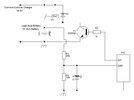I'm making a battery charge controller for Lead Acid & Sealed Lead Acid batteries using a PIC micro.I just plug an external voltage source (15V DC) & when it is below the set point it will start charge & when it is above the high limit it will turn off the charge.The analog voltage will read by the PIC microcontroller & controls the relay.
I set the Lower set point to 11.3V & Upper Set Point to 14.4V.My battery no load voltage is 12.0V.
The problem is when I hook the battery & plug the external voltage source (15V), the PIC voltage also sees as above 14.4V & stops charging.
How to solve this?
I set the Lower set point to 11.3V & Upper Set Point to 14.4V.My battery no load voltage is 12.0V.
The problem is when I hook the battery & plug the external voltage source (15V), the PIC voltage also sees as above 14.4V & stops charging.
How to solve this?


